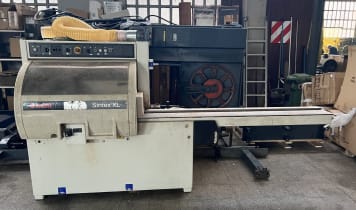In addition to frame presses, edge presses, and sawing/milling machines, the following types of equipment have been developed for windows and planing:
- Surfacing planers
- Thicknessing planers
- Combination planers
- Tenoners
- Window construction machines
- Chamfering planers
Surfacing planers
These surafce planers are stationary machines with a wide planing table. They are designed with simplicity in mind: they primarily comprise a steel table in the middle of which is a rotating planing roller arranged cross-wise. The workpiece is pushed across the table while the rolling planer does its job by removing a consistent layer of wood from the surface.
The blade roller in a surfacing planer can be adjusted as needed, which means that it can be moved down towards the work table to a defined height and then brought back. Creating a wooden workpiece with a specific thickness requires use of this setting.
Thicknessing planers
Thicknessing machines are the next step in the development of surfacing planers. If the workpiece has already been sufficiently smoothed and parallelised on the surfacing planer, it can be machined to the tenth of a millimetre on the thicknesser.
Thicknessing planers feature a base frame which contains the work table and integrated thicknessing blade. The thicknessing machine enables adjustments to be made to the whole work table instead of just the rolling planer. The frame and planing table together are used to determine the thickness of the entire workpiece.
Combination planers
Combination planers, or combined surfacing/thicknessing planers, can work on all sides of a workpiece using parallelisation and smoothing techniques to remove outer layers until the workpiece has reached the desired thickness. Combination devices are very popular as they are space-saving and work very efficiently.
Chamfering planers
Chamfering is comparable to ‘vertical planing’. Instead of a horizontal planing roller, chamfering machines use a vertical cutting roller. However, it is not freely movable as in a table mill. The chamfering machine uses a continuous stop onto which the workpiece can be securely attached.
The advantage of a chamfering machine is that the cutting roller is interchangeable, which makes it possible to create radial or layered chamfers within the workpiece edge.
Tenoners
The best way of joining heavy wooden beams is to use a mortise and tenon joint. These are precisely manufactured joints used in pre-prepared blind- and through holes. The machines used to create tenon joints are called tenoners and they primarily consist of a chamfering planer and a small circular saw. The cross-sections of tenon joints are relatively small, which means that tenoners are equally compact devices.
Window-making machines
A window-making machine is a special form of chamfering machine and planer which works on profiled wood. It smooths, polishes, cuts, mills and places grooves in this wood and then mitre cuts it to the desired length. Window-making machines require a range of processing stations to achieve these tasks, but once equipped, slats of wood can be machined on all sides in just one work cycle.
The machines are intended for large series and can thus maintain consistent precision across many workpieces. Once processed on a window-making machine, the window is mounted to the bracket device and firmly attached together in the frame press.



















